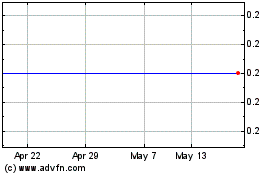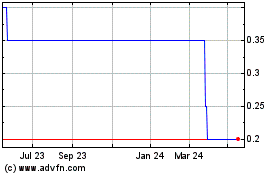Preclinical Results in DMD
January 24 2006 - 2:01AM
UK Regulatory
RNS Number:3353X
VASTox plc
24 January 2006
VASTox plc announces positive preclinical results in its lead Duchenne Muscular
Dystrophy programme
Oxford, UK, 24th January 2005 - VASTox (AIM: VOX), a leading chemical genomics
company, today announces promising results from its lead preclinical development
programme for Duchenne Muscular Dystrophy ("DMD"). DMD is a devastating disease
that affects young males for which there is currently no effective treatment.
Patients rarely survive beyond the age of 25.
For the first time, VASTox ("the Company") has demonstrated in vivo
up-regulation (increased production) of the protein utrophin by a number of
small molecules from their proprietary chemical library. This is a significant
development as utrophin has been demonstrated to replace the function of
dystrophin, which is missing in DMD patients and helps keep muscle cells intact.
Up-regulation of utrophin is widely viewed by the scientific community as a
highly promising avenue for the development of an effective treatment for DMD.
The gene for utrophin was discovered by Prof. Kay Davies FRS, CBE who is a
co-founder of VASTox. Prof. Kay Davies is an acknowledged leading expert in this
field and has studied extensively the utrophin replacement approach to the
treatment of DMD.
VASTox intends to optimise and develop the most promising lead candidates from
this on-going study, and conduct a more extensive screen for additional
compounds in 2006 with the aim of selecting a clinical candidate in 2007.
VASTox owns the rights to the relevant patents and licences relating to this
programme.
VASTox has already added further value to the compounds that have demonstrated
the ability to up-regulate utrophin by simultaneously conducting a preliminary
toxicology assessment using its proprietary zebrafish assays. This unique
approach allows the Company to eliminate potentially toxic compounds much
earlier in the development process than normal. This not only reduces the cost
and time of early drug discovery, but also minimises the use of mammals later in
development.
Commenting on the results, Steven Lee, PhD, CEO of VASTox said: "This is a real
breakthrough for the treatment of this terrible disease, and for the Company. We
have shown that our proprietary technologies can very quickly generate promising
lead compounds. We are also very pleased that we have validated our zebrafish
genomics platform to screen out potentially toxic small molecules, thereby
cutting-down on the need for higher animal testing."
Commenting on today's announcement, Prof. Kay Davies, Dr Lee's Professor of
Anatomy and Director of the MRC Functional Genetics Unit, University of Oxford,
and co-founder of VASTox, said: "I am delighted to see, for the first time, in
vivo up-regulation of utrophin using small drug-like molecules. I believe that
up-regulation of utrophin currently offers the most promising avenue for the
development of a new treatment for Duchenne Muscular Dystrophy. The Company has
not only brought commercial skills to academic research in this area but VASTox
also shares my commitment to developing effective therapies for the patients of
DMD."
- ends -
About Duchenne Muscular Dystrophy (DMD)
DMD is a congenital disease caused by the absence of the protein dystrophin. The
disorder occurs in about 1 in 3,000 males, with around 30% of DMD cases arising
in boys with no family history of the disease. The lack of the protein
dystrophin results in severe skeletal and heart muscle deterioration. The
disorder is progressive and it is rare for a male to survive beyond the age of
25. To date, there is no known cure for the disease.
About VASTox plc
VASTox is a chemical genomics technology company that discovers and develops
proprietary novel drugs and provides services to the pharmaceutical industry.
The company's most advanced drug development programme is focused on developing
a new treatment for Duchenne Muscular Dystrophy based on the up-regulation of
utrophin. A second drug development programme for Spinal Muscular Atrophy is
also progressing rapidly. VASTox has two additional programmes focused on
osteoarthritis and tuberculosis that are expected to be out-licensed prior to
entering the clinic.
The company's technology platform, which uses using zebrafish and fruitflies,
has the potential to dramatically decrease the time and cost of drug discovery
and development. This is because using whole organisms allows it to carry out
high volume, high content screening that delivers data which is highly
predictive of the efficacy and toxicity of potential drug compounds in humans.
VASTox is growing revenues based on marketing its unique technology platform and
its chemistry expertise.
VASTox was formed in January 2003 from the University of Oxford, by some of the
UK's foremost scientists who have taken a highly creative approach to the
problems involved in drug discovery and who have a proven record in delivering
technological excellence. The company listed on the AIM segment of the London
Stock Exchange in October 2004.
Further information about the company may be accessed at the VASTox website:
www.vastox.com
Contacts
VASTox
Steven Lee, PhD, CEO Tel: +44(0) 1235 443910
Darren Millington, Head of Finance
Citigate Dewe Rogerson
David Dible/ Mark Swallow / Valerie Auffray Tel: +44 (0)207 638 9571
This document contains "forward-looking statements" within the meaning of the
U.S. Private Securities Litigation Reform Act of 1995. Forward-looking
statements can be identified by words such as "anticipates", "intends", "plans",
"seeks", "believes", "estimates", "expects" and similar references to future
periods, or by the inclusion of forecasts or projections.
Forward-looking statements are based on the Company's current expectations and
assumptions regarding our business, the economy and other future conditions.
Because forward-looking statements relate to the future, by their nature, they
are subject to inherent uncertainties, risks and changes in circumstances that
are difficult to predict. The Company's actual results may differ materially
from those contemplated by the forward-looking statements. The Company cautions
you therefore that you should not rely on any of these forward-looking
statements as statements of historical fact or as guarantees or assurances of
future performance. Important factors that could cause actual results to differ
materially from those in the forward-looking statements include (factors
included in this presentation) and regional, national, global political,
economic, business, competitive, market and regulatory conditions.
This information is provided by RNS
The company news service from the London Stock Exchange
END
MSCBRGDBSUDGGLX
Vox Valor Capital (LSE:VOX)
Historical Stock Chart
From Jun 2024 to Jul 2024

Vox Valor Capital (LSE:VOX)
Historical Stock Chart
From Jul 2023 to Jul 2024
